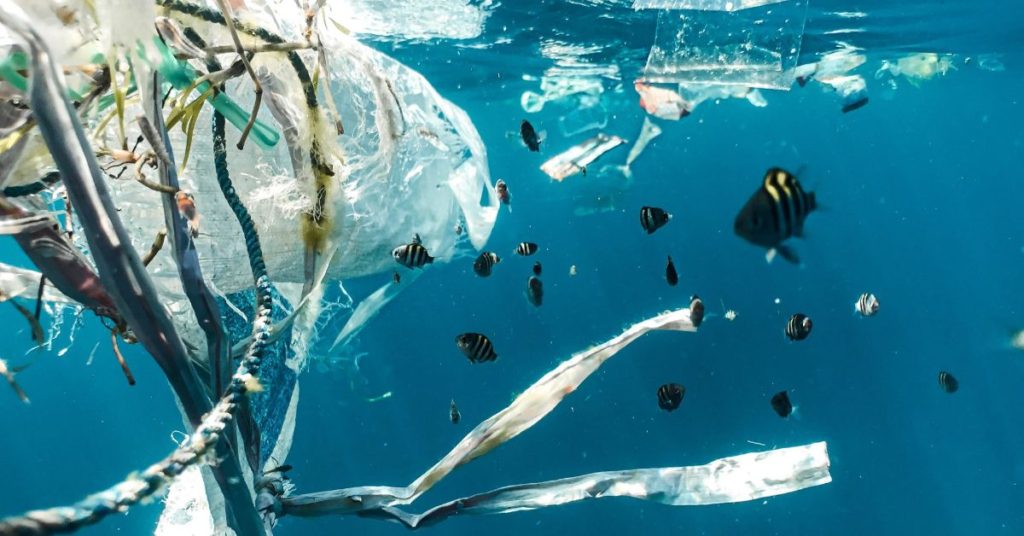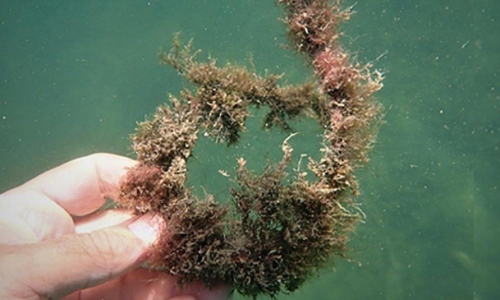Learn About the convergence of microplastics and invasive species as significant environmental issues that threaten marine ecosystems, and how Ascandra can remediate it.
Microplastics are small plastic particles measuring less than 5mm in size, and are found in a wide range of environments, including oceans, rivers, lakes, soil, and even in the air[1]. They are found in different forms such as fibers, beads, and fragments, and are often derived from larger plastic items that have broken down due to environmental factors, such as UV radiation and wave action.[2]
MICROPLASTICS, A GROWING THREAT FOUND EVERYWHERE
Ocean waters are particularly affected by microplastics, with studies finding high concentrations of microplastics in coastal areas, as well as in the open ocean. A study by the United Nations Environment Programme (UNEP) estimates that there are around 51 trillion microplastic particles in the ocean, weighing around 268,940 tons.[3] In addition to oceans, microplastics have also been found in freshwater systems. A study by the U.S. Geological Survey (USGS) found that microplastics were present in 83% of samples taken from rivers and streams in the United States.[4]
Plastic debris, which constitutes up to 87% of marine litter[5] , has been found to have significant negative impacts on marine species and ecosystems. Sources of entry of plastic materials into the ocean include land-based sources such as litter and sewage, as well as ocean-based sources such as fishing and shipping activities. Once in the ocean, plastic debris can move between different habitats, affecting each trophic level and creating hot spots of plastic accumulation in the ocean. One of the main ways in which plastic affects marine life is through its ability to act as a vector for the dispersal of marine invasive species.
WHAT ARE INVASIVE SPECIES?
Invasive species are non-native species that are introduced to new environments, where they can cause significant damage to native species and their habitats. The introduction of invasive species can occur through a variety of mechanisms, including human activity, which has been identified as a significant contributor to the spread of invasive species through marine transportation.
Microplastics and invasive species are two major environmental issues that have emerged as significant challenges to the global community. While they are distinct problems, they share commonalities that have created a convergent impact on marine ecosystems. Microplastics have a range of harmful effects, including entanglement and ingestion by marine life and the introduction of invasive species. But the emergence of microplastics and invasive species as convergent issues is linked to the transport of non-native species on the plastics, which fragment and float in the ocean for years as they travel vast distances.
Microplastics can then serve as a vehicle for invasive species, allowing them to travel long distances and colonize new environments. Once established, invasive species can have devastating effects on native ecosystems, outcompeting native species for resources, and altering habitats.
WHY DO THEY ATTACH ON MICROPLASTICS ?
Plastic is a potential dispersal vector of marine invasive species, as it is the most common marine debris and constituting 61–87% of all types of marine debris and is considered as one of the major threats to marine biodiversity.[6] According to a report of the OECD Global Plastics Outlook Database, Plastic production has increased exponentially in the last 60 years, from 0.5 million tons in 1960 to almost 460 million tonnes in 2019 with 10% of plastic production being introduced into marine ecosystems through land-based sources such as rivers, storm drains, urban runoff, sewage discharge, effluents from plastic manufacturing factories, landfills or recycling points, coastal areas due to the action of the wind and other human activities. Moreover, global distribution, buoyancy, and high levels of colonization of plastic debris greatly facilitate the transport of microbial communities, algae, invertebrates, and fish to non-native regions, causing significant economic and ecological damage.
The characteristics of plastic that make it a particularly effective dispersal vector for marine species include its persistence in the environment, buoyancy, and variety in terms of chemical composition. Plastic’s persistence means that it can remain in the ocean for long periods of time, providing a substrate for colonization by a wide range of macro and microscopic species. Its buoyancy allows it to float on the ocean surface, increasing the potential for dispersal over long distances. The variety of chemical compositions of plastic can also affect the types of species that colonize it, with some polymers being more conducive to colonization by certain species than others.
The differences in biocolonization of plastic debris according to its chemical composition has provided fundamental information about the invasion process mediated by plastic, and highlighted gaps in knowledge about this process. A wide range of species have been documented as being attached to plastic materials, including potentially invasive macrofauna, toxic microorganisms, and pathogens. Some species have been found to be more efficient at colonizing plastic than natural oceanic rafts, such as arthropods, annelids, and mollusks.
Marine ecosystems around the world are threatened by several factors related to human activity, such as biological invasions. Invasive species can have a significant impact on the invaded environment, altering the structure of the community and the functions of the ecosystem through competition with native species, introduction of pathogens, or indirect changes in habitat conditions.
DRASTIC IMPACTS ON MARINE LIFE
A wide range of species have been found colonizing plastic debris, including bryozoans, barnacles, polychaetes, hydroids, mollusks, arthropods, annelids, and cnidarians[7]. These species have been found to be transported by plastic debris over long distances, and have been found on plastic items in the ocean and stranded on the coast.
They are able to settle and develop quickly in new environments, leading to negative impacts on native species and ecosystems. microplastics (MPs) and nanoplastics (NPs), act as vectors for the dispersal of microorganisms and associated diseases in marine environments. The physical properties and widespread distribution of plastics provide a unique and stable habitat for microorganisms, which attract bacteria, viruses, plankton, and other microorganisms that adhere to its surface, enhancing their dispersion to different oceanic regions.
The presence of pathogens and invasive algae have been documented in plastic debris, which can invade new habitats and modify their structure, becoming a threat to the ecosystem. Additionally, several researchers have found antibiotic resistance genes, metal resistance genes and virulence genes in different species of bacteria in marine environments associated with plastic.[8] The study of the succession of plastisphere communities and the different factors that influence the transmission of microorganisms mediated by plastic is important to understand and mitigate its impact on marine ecosystems.
In conclusion, microplastics and invasive species are two convergent issues that pose significant challenges to the health of marine ecosystems.[9] While they are distinct problems, they share commonalities that have created a convergent impact on marine environments. To effectively address the threats facing our marine ecosystems, we need to take a comprehensive approach that encompasses waste reduction, improved waste management, stricter shipping regulations, and early detection and rapid response programs for invasive species. It’s crucial that we tackle the growing problem of microplastics, which pose a significant danger to marine life and ecosystems. That’s why innovative solutions like ASCANDRA, developed by Eden Tech, are important in the fight against microplastics. ASCANDRA uses biomimicking microscale capillary networks, or microfluidics, to treat microplastics from global natural water bodies, and has the potential for a significant positive impact on the environment. Only through concerted efforts like these can we hope to preserve the health and diversity of our oceans for future generations.
References
1. Rachid Dris, Johnny Gasperi, Mohamed Saad, Cécile Mirande, Bruno Tassin, Synthetic fibers in atmospheric fallout: A source of microplastics in the environment?, Marine Pollution Bulletin,Volume 104, Issues 1–2 (2016)
2. Combined Effects of UV Exposure Duration and Mechanical Abrasion on Microplastic Fragmentation by Polymer Type Young Kyoung Song, Sang Hee Hong, Mi Jang, Gi Myung Han, Seung Won Jung, and Won Joon Shim, Environmental Science & Technology (2017)
3.UNEP, Marine Plastic Debris and Microplastics Global Plan of Action (2017)
5. Beiras Ricardo, Galgani François, Panti Cristina, Borja Angel, Impacts of Marine Litter , Frontiers in Marine Science 6, 2019
4. U.S. Geological Survey (USGS), Microplastics in the Nation’s Rivers (2018)
6. García-Gómez José Carlos, Garrigós Marta, Garrigós Javier, Plastic as a Vector of Dispersion for Marine Species With Invasive Potential. A Review , Frontiers in Ecology and Evolution 9, (2021)
7. Rech S, Borrell Pichs YJ, García-Vazquez E. Anthropogenic marine litter composition in coastal areas may be a predictor of potentially invasive rafting fauna. PLoS One. 2018
8. Audrezet, François & Zaiko, Anastasija & Lear, Gavin & Wood, Susanna & Tremblay, Louis & Pochon, Xavier. (2020). Biosecurity implications of drifting marine plastic debris: Current knowledge and future research. Marine Pollution Bulletin.
9. Andrea Di Cesare, Lee J. Pinnell, Diego Brambilla, Giulia Elli, Raffaella Sabatino, María B. Sathicq, Gianluca Corno, Colin O’Donnell, Jeffrey W. Turner, Bioplastic accumulates antibiotic and metal resistance genes in coastal marine sediments, Environmental Pollution, (2021)

Nour Chebbi
Head Of Marketing
M.Sc. Microfluidics


